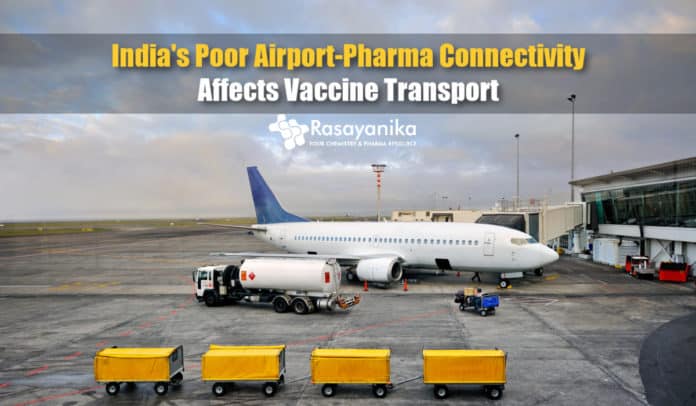Improper Air Infrastructure Drags Down COVID-19 Vaccine Transport
In the last couple of days, the spotlight has switched to the COVID-19 vaccine from the virus and after India approved two vaccines for emergency use, logistics have captured the attention. Since the world’s first immediate use approved vaccine, the Pfizer-BioNTech vaccine, has to be stored at -80°C, two of these approved COVID-19 vaccines have to be transported at 2-8 °C.
THE SII (Serum Institute of India), which has associated with AstraZeneca for the production of Covishield, is situated in the suburbs of Pune. This company is the biggest vaccine manufacturer in the world and was established in 1966. Even though the firm exports to over 100 nations, Pune doesn’t have a 24/7 working civilian airport that can manage massive cargo operations.
As SII begins exporting countless dosages of Covishield all around India as well as caters to worldwide orders, the civilian Pune airport, which is owned and governed by the Indian Air Force, is resurfacing and repairing runways. It is shut from 8 pm to 8 am, critically limiting the working hours and cargo shipping.
Additional to the limited operational hours, the Pune airport can’t handle wide-bodied aircraft for cargo as well as passengers
because of its small runway and absence of apron space.Both non-pharma and pharma industries near Pune have to depend on the airport in Mumbai for shipping or Bengaluru, Hyderabad, or Delhi airports. Pune airport also doesn’t have enough space to construct a bigger cold storage area, essential for vaccines and other medical products.
With the vaccine development and production, India is standing out as the world’s best pharma factory, when compared to other neighboring countries like China. It is ironic to see that pharma clusters in India are not well interlinked or lack a proper air facility for shipping.
Where are the pharma clusters?
Indian pharma sector is spread all over the country. Few states such as Sikkim, Uttarakhand, and Himachal Pradesh, which are less industrialized and hilly, embraced the establishment of the pharma sector for its comparatively eco-friendly nature.
There are pharma centers at Aurangabad & Pune in Maharashtra, Ahmedabad-Vadodara-Vapi-Ankleshwar belt in Gujarat, Haridwar-Pantnagar in Uttarakhand, and Baddi in Himachal Pradesh. Areas near Puducherry, Chennai, Hyderabad, and Mysuru-Bengaluru in Karnataka also have a flourishing pharma sector.
Apart from Chennai and Bengaluru airports, with sound international connectivity and shipping activities, the other airports have one or the other issue. The closest airport for the unit in Baddi is Chandigarh, operated and owned by the Indian Air Force. Likewise, the Sikkim unit relies on the Bagdogra airport, West Bengal. In the midst of all the operations to serve missions, concerns pertaining to security, safety, and land have meant that expanding apron space, runway expansions, building up cargo platforms has not been achievable.
What are the difficulties?
The Ahmedabad-Vadodara-Vapi-Ankleshwar belt and Aurangabad & Pune units depend on the airport facility in Mumbai for shipping. Most of the industries in the northern part of India depend on Delhi airport whereas the Sikkim unit depends on Kolkata airport. Besides the hike in operational expenses, multi-modal transport increases the inability to keep the required temperature affecting the quality of the vaccine or risk of contamination.
Aside from manpower & infrastructure, availability of power, multiple sops, shipping & in turn foreign exchange would be achieved if airports with good facilities are near to the manufacturing units.
Tailpiece
Even though building an airport overnight is impossible to do, it can never be a more ideal time when the government is concentrating on facilities, to prepare for the future with attention turning towards Mission Atmanirbhar and ships worldwide to transform India into a manufacturing hub.
Plans to build a new civil airport for Pune have already been made over two decades ago. The project has shifted from one location to another several times and the acquisition charges have raised high.
There is no scope of expansion for Bagdogra airport because of insufficient land. Although it manages a few international traffic-mainly of Bhutan’s Druk Air and to South East Asia- the facility is not adequate to serve the routine international freight.
The setting required for medicines, particularly the cold chain facilities, can easily be used for farm produce, which will also benefit the government’s aim of increasing the income from farming. With any luck, the coronavirus pandemic will expedite several projects that have been suspended till now.















































